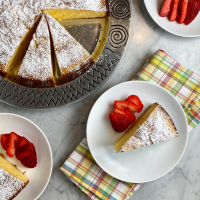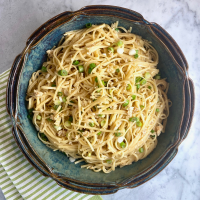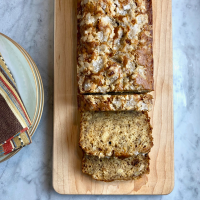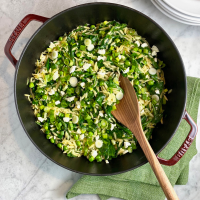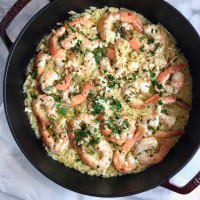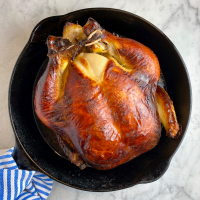
Crêpes have always been special to my family because my dad made them for breakfast on Sundays when I was growing up. We always make sure to have them at least once a year- on Christmas morning. We typically eat them simply sprinkled with sugar and occasionally with jam or fresh fruit as well.
I made these fancy crêpes for our celebratory Valentine’s Day dessert from a crêpe cookbook that my sister gave me for my birthday. ❤ I loved the browned butter in the crêpe batter. As a sauce fan, I also loved that these crêpes were served with two wonderful sauces.
This recipe was adapted from Crêpes: 50 Savory and Sweet Recipes by Martha Holmberg. I made the sauces and crêpe batter a day in advance. Delicious!
Yield: Makes 6 to 8 filled crêpes plus extra crêpes and sauce
For the Salted Caramel Sauce:
Yield: 3/4 cup (180 ml)
- 100 g (1/2 cup) granulated sugar
- 2 tsp light corn syrup
- 6 T heavy cream or crème fraîche
- 1 T unsalted butter
- 1/8 tsp pure vanilla extract
- 1/4 tsp coarse salt or coarse sea salt
- Put the granulated sugar, corn syrup, and 2 tablespoons of water in a small, heavy-bottomed saucepan over medium-high heat. Bring to a boil, stirring just until the sugar is beginning to dissolve.
- Let the mixture boil without stirring, occasionally swirling the pan, until it is a deep amber, very fragrant, and you can see tiny wisps of smoke, 4 to 12 minutes. Watch carefully!
- Remove the saucepan from the heat and carefully pour in a small amount of the cream; it will bubble up furiously. Whisk in remaining cream a little at a time so it doesn’t bubble over.
- Whisk in the butter, vanilla, and salt until the caramel is very smooth.
- Transfer to a serving bowl and let it cool to room temperature; it will thicken as it cools.
- Serve warm or at room temperature. (I made it a day in advance and refrigerated it overnight. I brought it to room temperature prior to serving.)
Note: Stored in an airtight container, the finished sauce will keep in the refrigerator for 1 month or in the freezer for 3 months.
For the Cinnamon Custard Sauce (Crème Anglaise):
Yield: 1 cup (240 ml)
- 1/2 cup (120 ml) whole milk
- 1/2 cup (120 ml) heavy cream
- 2 large egg yolks
- 50 g (1/4 cup) lightly packed light or dark brown sugar
- 1/2 tsp ground cinnamon
- pinch of coarse salt or sea salt flakes
- Heat the milk and cream in a medium saucepan over medium heat until it’s just beginning to steam. Watch carefully! Don’t let it boil- it will change the flavor.
- Meanwhile, in a medium bowl with a spout, whisk together the egg yolks, brown sugar, cinnamon, and salt until well blended but not foamy.
- Slowly pour half of the hot milk-cream mixture into the bowl with the egg mixture, whisking constantly and quickly.
- Return the pan with the remaining milk and cream to the heat and whisk the yolk-cream mixture into the pan.
- Switch the whisk to a heat-proof rubber spatula or a wooden spoon, and gently cook the sauce, scraping the bottom and sides of the pan, until the custard thickens and registers 175 to 180 F (80 to 82 C) on a candy or instant-read thermometer.
- Transfer to a serving bowl and let cool to room temperature. Chill in the refrigerator until cold, about 2 hours.
Notes: Half & Half can be substituted for the combination of whole milk and heavy cream. The finished sauce will keep for 3 days in the refrigerator.
For the Sautéed Apple Filling:
- 4 T (55 g) unsalted butter
- 4 firm, tart apples (800g / 1.75 lbs) such as Braeburns, peeled, cored, and cut into 1/2-inch (12mm) dice (I used 4 large (840g) Ruby Frost apples)
- 75 g (6 T) granulated sugar
- 1 tsp ground cinnamon
- pinch of coarse salt
- Melt the butter in a large skillet over medium heat.
- When the butter is foamy, add the apples and cook, stirring occasionally, until they’re almost tender, 5 to 8 minutes.
- Sprinkle the apples with the granulated sugar, cinnamon, and salt and cook, stirring often, until the apples are tender when pricked with a fork, 3 to 4 minutes more.
- Remove the pan from the heat and let the apples cool slightly.
For the Brown Butter Crêpes:
Yield: 15 to 18 8-inch crêpes
- 1 3/4 cups (420 ml) whole milk (can add up to a total of 2 1/4 cups (540 ml) to adjust consistency)
- 4 large eggs
- 1/2 tsp coarse salt
- 190 g (1 1/2 cups) all-purpose flour
- 6 T (85 g) unsalted butter
- butter or vegetable oil, for the pan
- In a small pan over medium heat, melt the butter. Continue to cook until the butter turns golden brown and smells nutty and delicious. Pour melted butter and browned milk solids into a glass measuring cup with a spout to cool before using.
- Put 1 3/4 cups milk (420 ml), the eggs, and salt into a blender. (I used a Vitamix.) Process for a few seconds to blend.
- Remove the lid and add the flour. Cover and blend until very smooth, about 20 seconds.
- Remove the lid, pour in the browned butter- including the toasty brown milk solids, cover, and process until combined, about 10 seconds more.
- Transfer the batter to a large glass measuring cup with a spout.
- Let the batter rest at least 5 minutes and up to 24 hours. (If resting for more than 30 minutes, store in the refrigerator.)
- Before making the crêpes, test the batter’s consistency: it should be as thick as heavy cream but not as thick as pancake batter. If it’s too thick, whisk in up to 1/2 cup (120 ml) of the remaining milk.
- Heat an 8-inch (20 cm) crêpe pan over medium-low to medium heat until it’s hot enough to make a drop of water sizzle upon contact. (I always check to make sure the base of the handle is hot.)
- Using a heat-proof brush, coat the pan with oil. (Alternatively, use a folded paper towel to coat the pan with 1/2 teaspoon of butter. The butter should sizzle but not turn brown. Adjust the heat of the pan, if necessary.)
- Using a ladle, pour about 1/4 cup (60 ml) of the batter into the center of the pan, and at the same time lift the pan from the heat, tilting and turning it in all directions sos the batter spreads evenly across the bottom of the pan in a thin circle. (If the crêpe has any holes in it, quickly add a few drops of batter to fill them in. If there is excessive batter, immediately pour the excess back into the bowl of batter.)
- Cook the crêpe until the edges begin to dry and lift from the sides of the pan and the bottom is nicely browned, about 1 minute.
- Use a table knife, slim spatula or your fingers to lift the crêpe and quickly flip it over. Smooth out any folded edges or pleats and then cook unit the center is firm and the second side is browned, about 20 seconds more. (The first side is almost always prettier and more evenly browned so it is noted as the presentation side.)
- Slide the crêpe from the pan onto a large plate.
- Repeat with the remaining batter, adjusting the heat and wiping the pan with more oil or butter as you cook.
- The finished crepes can be stacked on each other as they are done.
Note: Leftover crêpes can be wrapped tightly and stored in the refrigerator for up to 3 days. If storing them in the freezer, lay pieces of waxed or parchment paper between them so that they don’t stick together. They will keep in the freezer for 2 to 3 months. To thaw, let the stack sit at room temperature until the crêpes are pliable, about an hour.
To Finish the Dish:
- Position a rack in the center of the oven and preheat to 425 F(220 C).
- Butter the bottom of a baking dish. (or use cooking oil spray) (I only baked 4 filled-crêpes at a time, so I used a small baking dish. If baking all at once, use a 9×13-inch baking dish. The crêpes should be tightly packed.
- Lay the crêpes presentation-side down on a clean work surface.
- Divide the apples equally among the crêpes, spooning them onto the bottom third of each one.
- To fold the crêpes, pull the bottom edge of each crêpe up and over the apples, then roll it up a half turn. Tuck in each side, and finish rolling up from the bottom.
- Arrange the crêpes seam-side down in a single layer in the prepared baking dish.
- Bake until heated through, 4 to 10 minutes.
- Spoon a thick ribbon of cinnamon custard on a dessert plate.
- Lay a crêpe over the custard sauce and drizzle the salted caramel sauce over the top. Serve immediately.











